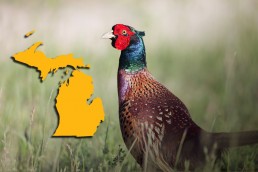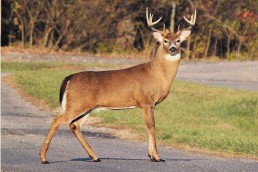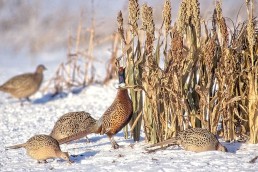Michigan still has pheasants!
SHARE THIS POST
From the Michigan DNR
|
Ring-necked pheasants are beautiful birds, with their rainbow of feather colors and impossibly long tails. Since their introduction to Michigan in 1895, they have offered delightful views to those lucky enough to spot them.
|
Pheasants are omnivores, feeding on insects, seeds, grains, corn kernels and buds. They nest on the ground among low grasses, and females lay 10-12 olive-buff-colored eggs per year. After about three to four weeks, the eggs hatch and the speckled young pheasants can follow their mother around shortly after hatching.
Pheasants use grassland habitat in just about every season of the year. Optimal pheasant habitat must include a combination of grasslands, idle fields, wetlands, croplands, haylands and shrublands. Undisturbed low- to medium-high grasses and legumes are vital for nesting and brood-rearing habitat. Wetlands, windbreaks and dense covers of cattails or switchgrass protect the birds from heavy snow and cold winds in the winter. Fields of grain and weeds provide a consistent winter food supply.
Pheasant numbers decline
It’s no secret that pheasant populations have declined in Michigan over the last several decades. Grassland habitat, along with the quality of pheasant habitat, has decreased greatly over the past 70-80 years. In the 1940s and 1950s, farms had small fields, from 10 to 20 acres in size, surrounded by grassy fencerows and diverse crop rotations. The number of farms declined from 190,000 in 1940 to less than 60,000 by 1990.Farming practices also have changed over time. Many current practices aimed at agricultural efficiency are not wildlife-friendly, which has been detrimental to pheasants. Such practices include early and numerous cuttings of hayfields, spraying of pesticides and herbicides, double-cropping, and fall plowing and disking of crop residues.
Are you enjoying this post?
You can be among the first to get the latest info on where to go, what to use and how to use it!
In addition, many grasslands have been converted into subdivisions and business developments, contributing further to the decline in grassland habitat.
But pheasants still in state

For those wishing to harvest a wild pheasant this fall, pheasant hunting season is Oct. 10-31 in the Upper Peninsula in Menominee County and portions of Iron, Marquette, Dickinson and Delta counties; Oct. 20-Nov. 14 in the Lower Peninsula and Dec. 1-Jan. 1 in selected areas of Zone 3. The bag limit is two male pheasants daily, with four in possession. A base license is required to hunt pheasants.
The MPR
The Michigan Pheasant Restoration Initiative is working to improve and enhance Michigan’s remaining grasslands on private and public lands in southern Michigan. This includes planting diverse mixes of grasses and wildflowers for birds. Extensive grassland restoration work is in progress at Lake Hudson State Recreation Area in Lenawee County, Verona State Game Area in Huron County, Sharonville State Game Area in Jackson and Washtenaw counties, and Maple River State Game Area in Gratiot County as well as other public and private lands in southern Michigan.Made up of many partners, the Michigan Pheasant Restoration Initiative is a conservation initiative to restore and enhance Michigan pheasant habitat (grasslands), populations and hunting opportunities on private and public lands via pheasant cooperatives. The initiative works by acquiring state, federal and partner resources to assist landowners in the cooperatives to improve wildlife habitat on their properties and by improving grassland habitat on selected state game areas, recreation areas or other public lands. To learn more, visit www.mi.gov/pheasant.
MWO
SHARE THIS POST
Did you enjoy this post?
You can be among the first to get the latest info on where to go, what to use and how to use it!
Bobby Bergren
“Bobby B” Bergren is a smallmouth bass fishing fanatic who’s passion is fishing the Great Lakes. He has multiple first-place tournament wins on Lake Michigan. Additionally, he is a die-hard ice fishing enthusiast who targets bluegills, and dabbles in hunting and knife collecting. Bergren also engages in content creation and digital marketing for MidWest Outdoors.



